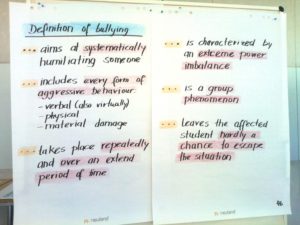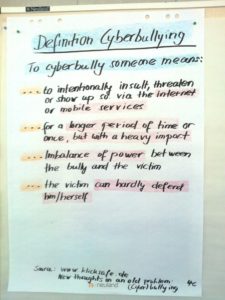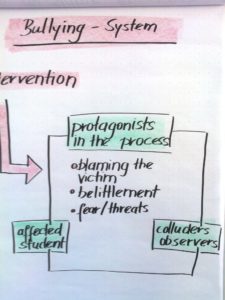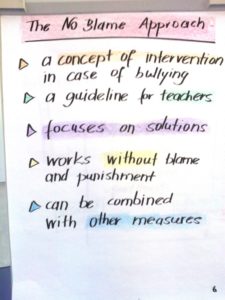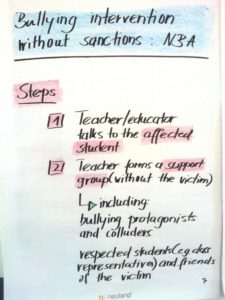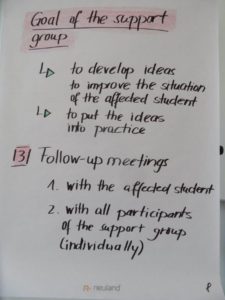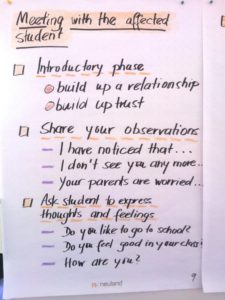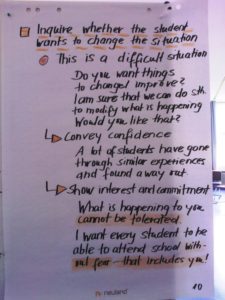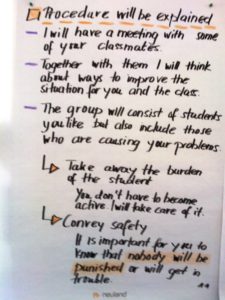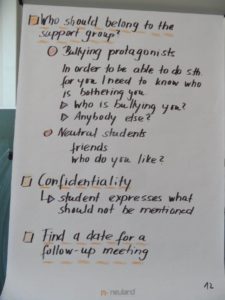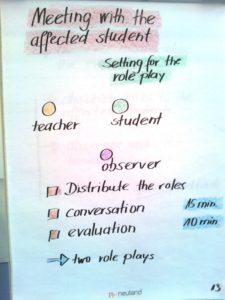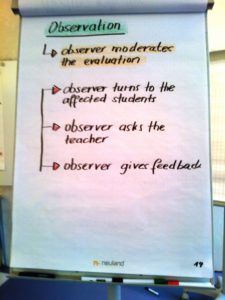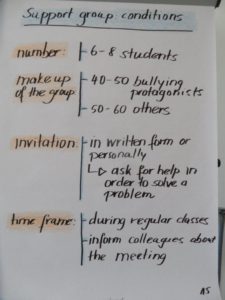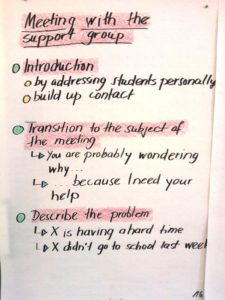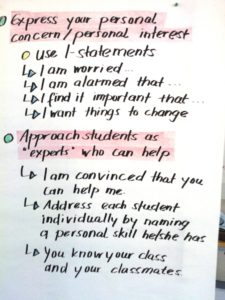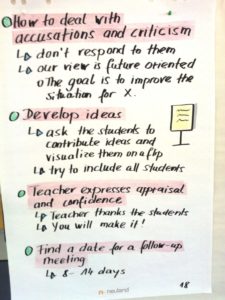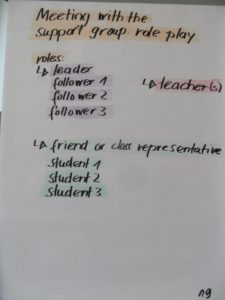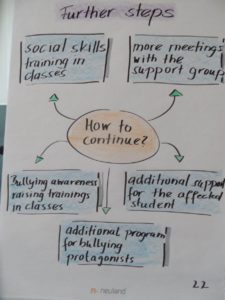Category: Chapter 7: Bullying intervention tool: the No Blame Approach
7.1 Context of the No Blame Approach
The No Blame Approach (NBA) has been developed in the beginning of the 1990-ties in England by George Robinson, long term headmaster of a school for children with behavioral disorders and Barbara Maines, school psychologist. They were looking for a constructive method to fight bullying in the case of a teenage boy whose teacher had asked them for help as Maines and Robinson describe in their publication: Crying for help – the No Blame Approach to Bullying: “We wanted a strategy that was safe, did not accuse, interrogate or alienate young people. We wanted a process that would improve relationships between young people and the adults working with them.” 1
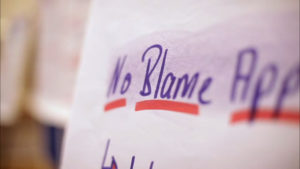
Up to then different bullying intervention tools have been applied which foresaw severe consequences for the bullying student. However, punishment and negative consequences did not necessarily improve the situation for the bullied child but also carried the danger of revenge. So Barbara Maines and George Robinson designed a concept which did not focus on punishment but rather on the belief that, if group dynamics in a classroom changed – meaning that the bullying actions would no longer be considered cool or funny by the other classmates – the bully will change his behavior and stop bullying.
And the results of the NBA intervention proved that it worked. In most cases the bullying was stopped.
By now the No Blame Approach is used in the following countries: New Zealand, Switzerland, the Netherlands, Belgium and Germany.
7.2 Theoretical background

The development of the NBA was inspired by the ideas of Thomas Gordon, an US-American clinical psychologist who became well known with his publication: “Parent Effectiveness Training”, a plea for a nonviolent education. It also represents a systemic approach, involving several members of a class in a change process. The systemic approach was introduced by the US-American therapists Steve de Shazer and Insoo Berg and their team at the Brief Family Therapy Center in Milwaukee. The therapists were convinced that individual behavior changes in a system (a group) influence the functioning of the whole group.3 Consequently, a shift in behavior of some group members will have an impact on the other ones. Another important aspect is the future and resource – orientation. The idea is not to look back and not to analyze reasons for behavior patterns. It tries to create a setting which enables looking for solutions. The attitude of the teacher is to initiate a change in behavior. The bullying student will not be confronted with his wrongdoing (“no blame”) but he/she will be integrated into a group process to improve the situation for the victim. Resource orientation means that the bully is not only perceived as a deviant person but also as someone who has shown positive character traits before.
In case of bullying, this process can be initiated by the class teacher or another teacher who knows the class well, a social worker or school psychologist.4 Often the teacher has observed a change in behavior of the bullied student, parents turn to the teacher or bullying activities are reported by others. Since the NBA is working without blame the wording will also be changed, the teacher will address the victim as affected student and bullies will be called protagonists or actors. The process consists of 3 steps:
-
- A talk with the affected student
- A meeting with a selected group of students of the class (neutral students, actors and bystanders) which is called “support group”
- Follow-up meetings with the affected student and the members of the support group.
7.3 The three steps of the No Blame Approach
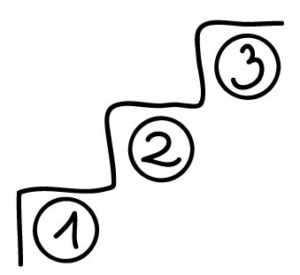 No Blame Approach consist of three steps:
No Blame Approach consist of three steps:
7.3.1 Meeting with the affected student
7.3.1 Meeting with the affected student
The first meeting with the affected student is crucial. The teacher expresses his/her concern about the situation, assures the student that he/she will take initiative to help him or her and conveys confidence that the situation will change. By doing this the teacher signalizes first of all that he/she knows about the bullying and is determined to intervene.
The teacher informs the parents of the affected student about the intervention (see also comment: Parents and the No Blame Approach). Parents can contribute a lot to the success of the NBA by being positive about it and not insisting on sanctions. Research has shown that parental intervention (addressing the bully themselves or contacting the parents of the bully) leads to an aggravation of the incidents and is most likely contra productive.5
7.3.2 Meeting with the support group
The second step (and most challenging) one is the meeting with the “support group”, consisting of the bully(ies) and colluders/bystanders on the one hand and friendly students on the other hand (6-8 pupils). The students receive an individual invitation for a meeting during classes. There needs to be a close consultation with the teacher whose lesson is concerned. The support group meets in a separate room. Initially, the teacher expresses also here his/her deep concern about the fact that one of the students is being bullied and clarifies that this is an unacceptable situation which needs to be changed. He/she tries to arouse empathy with the affected student. Then he/she is going to ask the students for help to overcome the bullying and addresses them as “experts” for the situation in class. This expresses the explicit difference to other bullying interventions.
This attitude also involves the protagonists, in a setting where it is obvious that the teacher knows who is bothering whom it will not be possible for the bullies to just continue. They are observed by teachers and classmates. But – and this is the big chance for them: stopping the deviant behavior now also means not being punished plus having the chance to re-define their role in class, it is face saving. The teacher explicitly mentions a positive skill each of the students has, including the bullies, focusing on resources rather than on deficits. The next step is to ask the students to come up with concrete ideas how to help/support the affected student X. What can be done? (E.g. walking X home, inviting X, spending time with X…) The teacher takes notes of the ideas on a flipchart/ blackboard and adds the names that are responsible for what. In the case of the protagonist(s), it is sufficient to say: I will stop bothering him/her.
Finally, the teacher thanks the students for their constructive ideas and support and finds a date for follow-up meetings.
7.3.3 Follow-up meetings
The first meeting will be held with the affected student in a separate room.
If the answers are positive, the bullying has stopped and classmates are friendly and supportive the NBA was successful. The teacher will thank the student for the trust and invite him/her to turn to him/her in case of difficulties.
However, if this is not the case, the teacher will announce a second meeting with the support group and assure the student that he/she will continue to take care of the problem.
After the meeting with the affected student the teacher meets the members of the support group individually. He/she asks for an estimate how the affected student is feeling now. Have things improved? What did you notice? Were you able to contribute? Do you have any other ideas what can be done? In case of a positive course (the bullying stopped) the teacher expresses his thankfulness about the constructive role the student played. In case of an unsatisfying development the teacher announces another meeting of the support group in order to reflect the effectiveness of measures and develop new ideas.
Nevertheless, in case of a failure, other measures should be considered.
7.4 The No Blame Approach and cyberbullying
As pointed out in chapter three, in a cyberbullying case it might be difficult to identify the bullies unless the authorities are contacted to find out the IP address. Also, the provider can be contacted to take down the website. But even in a situation where it is not clear who is the wrongdoer, in the beginning, the No Blame Approach can be applied. A cyberbullying attack can harm the affected student much more since it is a 24/7 harassment visible for anybody in the net.
Sometimes there might be a suspicion who is responsible for the act. in this case, the potential bully should be invited into the group. One possibility is to set a deadline for deleting the offending messages/website (the same day). If the bully is known he/she will also be invited to join the support group. Deleting the message/film/website etc. is mandatory.
If the cyberbullying has caused severe psychological and personal damages further steps need to be taken to stabilize the student (e.g. counseling, therapy).
7.5 Why is it good for teachers to know and apply the No Blame Approach?
The fundamental idea of the NBA is to have a tool at hand which significantly improves the possibility to stop bullying. Punitive measures always carry the danger of revenge on the part of the bully, a vicious circle of fear and harm. Measures like swapping the class, especially if the victim is asked to change classes, are disadvantageous for the student.
Ideally, the NBA is not a single tool in school but is embedded in a set of measures e.g. the mediation club, awareness raising activities and other (preventive) programs.
7.6 Guidelines for implementation in schools
Experiences show that in a lot of cases committed teachers started the implementation of the NBA at their school. After participating in an NBA workshop several steps were initiated to inform the school community.
7.6.1 Informing the headmaster and colleagues
The headmaster and other teachers will be informed in detail about the steps of the concept, the philosophy of the approach and organizational conditions. The fact that this is a non-punitive tool will certainly provoke discussions amongst the teachers. Often the approach is accepted but not applied by all teachers. If this is the case it is important to ensure a general support of the application even if not every teacher agrees that he/she will work with the NBA. The application can also be delegated to a convinced colleague who knows the class. It should be agreed on that open dissent should not be expressed. However, the support of the headmaster is crucial for a successful implementation.
Sometimes the whole teaching team is interested in participating in the NBA workshop which is an opportunity to fully understand the program.
Many schools have developed their own profile, the “school program”. It might be considered to officially include the NBA and other possible tools of constructive conflict resolution into the school program.
7.6.2 Informing the parents
In several countries there are regular meetings of the class teacher and the parents. A meeting is a good opportunity to inform the parents about the introduction of the NBA in case of bullying at school. Sometimes parents are also interested in attending a NBA workshop if possible.
If a meeting is not scheduled for the near future parents should be informed in written form to explain the approach. It is advised to inform the parents of an affected student in a concrete case.
Annalena Scholz, teacher at the Aloisiuskolleg in Bonn: “Before the introduction of the NBA it was important to inform all colleagues and the principal to gain their support. And the concept works. We are able to stop difficult bullying situations. It was also important to explain the approach in detail to the parents of bullied children.”8
7.6.3 Organization
What is required: a room where the meeting with the affected student and the support group can take place without interruptions, a flip chart or blackboard, a circle of chairs, duration: Approx. 20 minutes meeting with the affected student, 30 – 40 minutes meeting with the support group.
The NBA is a tool which does not need a lot of preparation. What is essential is a room for the meetings with the affected student and the support group where no interruptions are allowed during the meetings, a corner somewhere in another room is not acceptable. If possible there should be a flipchart or a blackboard where the teacher can collect the ideas of the support group. Everybody should be able to look at each other, so a circle (with or without tables) is a good solution.
There should be close communication between the teacher who will apply the NBA and the teacher who is teaching in class. He/she has to be informed that 6 – 8 students will participate in the support group meeting.
At the end of the chapter interested teachers can find guidelines for the three steps of the concept.
7.7 Guidelines for a teacher training
 |
Duration:
7,5 hours including lunch break and short coffee breaks |
 |
Materials: (What is required: depending on the size of the group)
A circle of chairs (no tables), |
 |
Group size:
6 – 10 participants: 1 trainer |
 |
Instruction for implementation:
Multipliers who want to offer a No Blame Approach workshop need to have participated in a workshop before or already have experience in applying the approach, e.g. teachers, social workers. The workshop members can be a team of one school or a mix of teachers (social workers, psychologists) from different schools, sometimes one or two parents are also interested and can be included. Handouts with instructions (e.g. guidelines for the meetings) have to be prepared. An example of a possible structure of a one-day training of the No Blame Approach including samples of flipchart visualizations is added. |
7.8 No Blame Approach Workshop: Sample Agenda
 |
Duration:
1 day |
 |
Group size:
6 – 16 participants/ 1 or 2 trainers |
| Exercise, handout number | Time | Method | Material |
| Welcome, introduction Previous experiences with bullying interventions (positive/negative) |
20 min |
|
Flipcharts: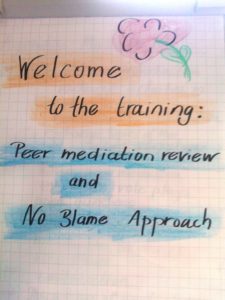 |
| Agenda | 10 min | Flipcharts: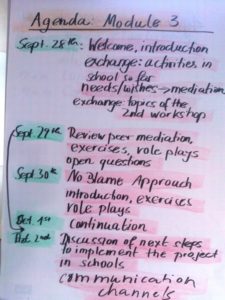 |
|
| Understanding bullying How do I recognize bullying? “Bullying glasses” |
40 min | Groups of 2-3 Collection of points on pin board |
Flipcharts: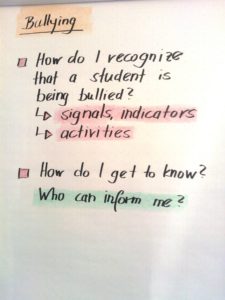 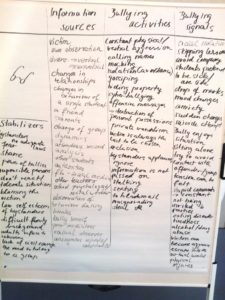 |
| Definition of (cyber) bullying | 5 min |
Flipcharts:
|
|
| Break | 15 min | ||
| The Bullying system | 30 min | ||
Preparation 1st role play: meeting with the affected student
|
90 min | Groups of 3 | |
| Lunch | 60 min | ||
Preparation 2nd role play: meeting with the support group (H12, H13, H14)
|
120 min | Depending on the group size: 1 or 2 role plays (parallel) |
Handouts: guideline, evaluation Teachers handout 3: Guideline meeting with the support group |
| Break | 15 min | ||
| Follow up meetings with affected student and support group How to continue? |
Flipcharts: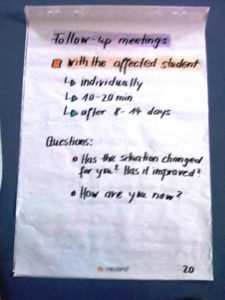 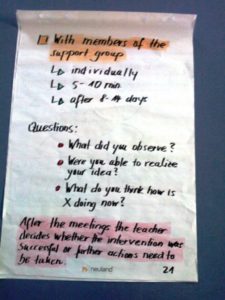
|
||
| Parents and the NBA Open questions |
Handout: Parents | ||
| Evaluation Goodbye |
Comment: This is a possible agenda for a 1-day-long workshop. If there is more time available, the trainers can include additional activities or exercises (see: Additional material).
7.8.1 Welcome, introduction
 |
Duration:
approx. 20 min |
 |
Aim:
Getting to know each other, participants are sharing their motivation for attendance, reflection of previous experiences with bullying situations. |
 |
Materials:
Flipchart No. 1, (flipchart samples see additional material) |
 |
Instruction for implementation:
After welcoming the participants the facilitators make sure that everyone gets the chance to introduce him/herself in case they have not met the others beforehand. They ask for the motivation to attend the workshop and how long the teachers have been teaching at their school. Next questions:
|
 |
Source:
Further reading:
|
7.8.2 Agenda
Overview of the program
 |
Duration:
Approx. 10 min. |
 |
Aim:
Participants receive an overview of the workshop program and are informed about the relevance of active involvement. |
 |
Materials:
Flipchart No. 2. |
 |
Instruction for implementation:
The facilitators give a brief overview of the workshop agenda.
At the end of the training, participants will discuss possible additional steps to combat further bullying and deal with open questions. |
7.8.3 How do I recognize bullying?
 |
Duration:
40 min |
||||||||
 |
Aim:
Participants will be introduced to the analytical tool “bullying glasses” in order to recognize a bullying situation. They will sharpen their observation by reflecting possible signs like bullying activities and bullying signals or hints from colleagues, students etc. |
||||||||
 |
Materials: | ||||||||
 |
Instruction for implementation:
The facilitators ask the participants to form small groups of two or three persons in order to reflect the questions on flipchart No. 3 (Approx. 5 minutes).Facilitators have prepared a chart on the pin board:
Facilitators invite the participants to share their collection of answers. One facilitator moderates the exchange and the other one takes notes, classifying the answers and writing them down. There is no discussion at this point, just the collection of answers and the correct classification. If there is no fluent exchange, the trainers try to stimulate further thoughts, e.g.:
Once the columns have been filled in, facilitators introduce the “bullying glasses”, explaining that not only one or two observations/signals/activities justify labeling a certain behavior as bullying. But if a teacher observes several symptoms in different columns there is a strong likelihood for bullying. Also: Once a teacher becomes suspicious that there might be a case of bullying it is helpful to put on the bullying glasses and have a close look at the specific situation of a student. |
7.8.4 Definition of bullying
 |
Duration:
5 min |
 |
Aim:
On the basis of the definition of bullying and cyberbullying participants will be able to distinguish between a conflict between two or more parties and a bullying situation. |
 |
Materials: |
 |
Instruction for implementation:
After the introduction of the bullying glasses the definition of bullying will be presented. In this context, the facilitators emphasize that bullying is not a case for peer mediation since there is an extreme power imbalance between the protagonists.
|
7.8.5 Bullying System
 |
Duration:
10 min |
 |
Aim:
Participants are introduced to the basic idea of a systemic approach, meaning that bullying is a group phenomenon which involves protagonists (the bully or bullies), colluders, bystanders, and observers. It is a functioning destructive system of a group which needs an intervention from the outside in order to change the situation for the better. Participants understand that the bullied person is hardly ever able to disburden him/herself. |
 |
Materials:
Flipchart No. 5 |
 |
Instruction for implementation:
The facilitators present bullying as a closed system with different roles. There are protagonists (the bully or bullies), colluders, bystanders, and observers. Since there is an extreme power imbalance between the bullies and the bullied student, an intervention from outside is necessary. The facilitators point out that bullying will not be regarded from the perspective of the offender and the victim but rather from a systemic approach. This means that representatives of the class will be in the focus including the protagonists, colluders, and observers as well as the affected student. Bullying is a group phenomenon. |
7.8.6 The No Blame Approach – characteristics
 |
Duration:
10 min |
 |
Aim:
Participants get to know the “special” attitude of the NBA. Contrary to common educational interventions in case of bullying the teacher will not blame the bully/bullies but rather involve him/them and other students in a process of behavior change, thus initiating a supportive structure for the bullied student and an end of bullying activities. |
 |
Materials:
Flipchart No. 6 |
 |
Instruction for implementation:
Facilitators explain the characteristics of the NBA. There is possibly a need to discuss the aspect: “no blame, no punishment” since this contradicts the usual educational responses. If participants are very critical it is helpful to talk about bullying cases where the offender was punished and might have taken revenge or where a bullied student left the class, in both cases a win-lose result. The NBA tries to change behavior patterns by influencing group dynamics and thus withdrawing a supportive atmosphere for the bullying protagonists. |
 |
Background information:
The concept was developed by George Robinson and Barbara Maines in the 1990-ies in England. In 2002 Christopher Szaday introduced it in Switzerland since 2003 Heike Blum and Detlef Beck from the German organization Fairaend have been spreading the approach in Germany.Furthermore, the concept is in use in the Netherlands, Belgium, Luxembourg, Australia and New Zealand. |
7.8.7 Bullying Intervention without sanctions – overview of the steps of the process
 |
Duration:
10 min |
 |
Aim:
Participants will be introduced to the steps of the NBA approach and get an idea about the concrete procedure. |
 |
Materials: |
 |
Instruction for implementation:
The facilitators point out that these two flipcharts give an overview of the NBA procedure. The facilitators comment on the illustrated steps: Firstly, the teacher meets with the affected student in order to win his/her trust and his/her agreement to intervene. This meeting is crucial, the teacher should not only show concern about what is happening but also his/her commitment to help and confidence that the problem can be solved. The student will be informed about the planned steps. In order to form the support group the teacher asks the names of friends and of classmates who are still supportive. On the other hand, he/she asks who is bothering the affected student (offender and bystanders). The goal of this meeting is not
The meeting lasts 30 – 45 minutes. The student should be relieved of any responsibility, the teacher signals his/her commitment. A date for a follow-up meeting will be found (within 8 – 14 days), until then the student observes carefully what happens. Secondly, the teacher forms a support group. This group includes 3 – 4 bullying protagonists plus 3 – 4 friends of the affected student or at least neutral students.The group´s unique factor is that it is not a support group for the affected student but for the teacher who asks for help to solve the bullying problem.The support group aims at developing ideas and measures which can be carried out by members of the group to stop bullying activities. The meeting with the support group will take place during regular classes (colleagues need to be informed beforehand). Students will be invited personally or in written form, the purpose of the meeting will not be mentioned, just the need for solving a problem together. The teacher shows an appreciative attitude towards all participants without blaming anybody and mentions skills and resources each and every student has to help. Thirdly, follow up meetings with the affected student and members of the support group (individually) will take place 8 – 14 days later. The teacher talks to the affected student in order to find out whether any (positive) changes occurred and how he/she is doing.There will also be individual meetings with the group members to evaluate the situation. Have the students been able to put their ideas into practice? Has the bullying stopped? At this point, the facilitators don´t allow a lot of questions. Open questions can be answered later on when the steps will be dealt with in detail. |
The concept was developed by George Robinson and Barbara Maines in the 1990-ies in England. In 2002 Christopher Szaday introduced it in Switzerland since 2003 Heike Blum and Detlef Beck from the German organization Fairaend have been spreading the approach in Germany.Furthermore, the concept is in use in the Netherlands, Belgium, Luxembourg, Australia and New Zealand.
7.8.8 Meeting with the affected student
 |
Duration:
15 min |
 |
Aim:
Participants receive a detailed overview how to approach a bullied student including a possible interview guide. |
 |
Materials:
Flipcharts No. 9, 10, 11, 12 – fastened on a pin board next to each other |
 |
Instruction for implementation:
The facilitators explain that the group is now at the point to actually start with the training of the 3 steps of the concept. The first step is to meet with the affected student. Depending on the situation the teacher will call the student at home (if he/she is not going to school anymore) or contact him/her in school. The meeting will be arranged in a separate room where nobody will disturb them. The teacher greets the student warmly: “How nice to see you. Don´t worry I´m not talking about the lessons that you missed during the last days…” He/she will share his/her observations: “I have noticed that…” In the next phase, the teacher asks how the student feels at school. It is not necessary to go into details of the bullying incidents but rather to get a general idea. The teacher will question the student concerning his/her will to change the situation, will convey confidence and express his/her commitment to help. Flipchart No. 11 The teacher explains the next steps, emphasizes that he/she wants to relieve the burden and conveys safety. Flipchart No. 12 Next, the teacher will inquire the names of friends or companions of the affected student but also the names of the bullying protagonists. Afterward, he/she assures confidentiality and finds out what should not be mentioned. Finally, the student is asked for his/her approval to proceed and a date for a follow- up meeting is agreed on.At the end of the presentation of the guideline for the talk, the facilitators will underline that it is of utmost importance to create an atmosphere of trust and confidence during the whole conversation. |
7.8.9 Guideline: Meeting with the affected student
- Introductory phase
Build a relationship
Build trust - Share your observations
I have noticed that…
I don´t see you anymore…
Your parents are worried… - Ask the student to express his/her thoughts and feelings
Do you like coming to school?
Do you feel good in your class?
How are you? - Inquire whether the student wants to change the situation
This is a difficult situation
Do you want things to change/to improve?
I am sure that we can do something to modify what is happening. Would you like that? - Convey confidence
A lot of students have gone through similar experiences as you and found a way out. - Show interest and commitment
What is happening to you cannot be tolerated.
I want every student to be able to attend school without fear – that includes you. - Procedure will be explained
I will have a meeting with some of your classmates.
Together with them, I will think about ways to improve the situation for you and the whole class.
The group will consist of students you like but also include those who are causing your problems. - Take away the burden of the student
You don´t have to become active. I will take care of it. - Convey safety
It is important for you to know that nobody will be punished or will get in trouble. - Who should belong to the support group?
- Bullying protagonists
In order to be able to do something for you, I need to know who is participating in giving you a hard time.
Who is bullying you? Anybody else? - “Neutral” students
Friends
Who do you get along with? - Confidentiality
Student expresses what should not be mentioned. - Agree on a date for a follow- up meeting
 |
Source:
|
7.8.10 Evaluation: Meeting with the affected student
Depending on the size of the group the role play can be evaluated by a facilitator and a group member (observer). Here are lead questions for the evaluation.Step 1: The “affected student” will be asked
Step 1: The “affected student” will be asked
- How are you doing now?
- Which phrases/behavior/attitude were helpful for you?
- Were you able to build trust?
- Anything that was not constructive?
- What else could have been helpful/positive?
Step 2: Questions to the “teacher”
- How are you doing now?
- What did you manage well?
- What was difficult?
Step 3: Feedback of the facilitator (observer) (directed at the teacher)
- I liked…
- Some ideas on what the teacher could consider/change in the future
 |
Source:
|
7.8.11 Role play teacher/student meeting
 |
Duration:
50 min |
 |
Aim:
Participants will conduct the first role plays in different roles. There will be two rounds offering the chance to either “play” the teacher or the affected student and thus experience how the guideline for the talk is working. |
 |
Materials:
Flipchart No. 13, guideline for the meeting with the affected student (prepared copies), evaluation guideline: meeting with the affected student (prepared copies), two role play settings (enough copies for the subgroups), |
 |
Instruction for implementation:
The facilitators ask the group to split up in subgroups of three. They distribute the copies of the guideline for the meeting (Flipchart No. 13). The participants distribute the roles amongst themselves (1 teacher, 1 student, 1 observer) Teacher and student face each other, the observer keeps a little distance. Teacher and student receive role descriptions. If possible the subgroups find a quiet corner to practice the role play. Two role plays with alternating roles will be conducted. The facilitators will visit all subgroups in order to get an impression of how it is working. Flipchart No. 14 After each round, there will be an evaluation which will be moderated by the observer (if applicable by one facilitator). The facilitators will remind the observers to focus on constructive feedback: “What went well? What did you like? Which phrases/expressions were positive?” “What could be improved?” (Find more detailed instructions in the handout: evaluation guideline).After the evaluation in small groups, the facilitators ask the subgroups to return and the whole group reflects the following question:“What can be helpful in this introductory meeting?” |
7.8.12 No Blame Approach Training: Support group: conditions
 |
Duration:
5 min |
 |
Aim:
Participants will get to know the set-up of the support group. |
 |
Materials:
Flipchart No. 15 |
 |
Instruction for implementation:
The facilitators introduce the size and conditions (Flipchart No. 15) of the support group. The group consists of 6 – 8 students, who receive a written or personal invitation which should not include the name of the affected student. The meeting takes place outside the classroom in a separate room during regular classes to avoid resistance.
|
7.8.13 Meeting with the support group
 |
Duration:
30 – 40 min |
 |
Aim:
Participants become acquainted with the procedure of the meeting with the support group. |
 |
Materials: |
 |
Instruction for implementation:
The facilitators explain the procedure (Flipchart No. 16) of the second step of the NBA: The teacher greets each student personally and tries to create a positive atmosphere by asking some general questions (but not too long), then leads to the topic of the meeting, stressing that they are here because he/she needs their help. Then the teacher points out how the affected student is doing (no use of the word bullying, no blame) stating that a member of the class is having a very hard time. The teacher has to be prepared that this is the first difficult moment since the bullying protagonists might start to defend themselves or even accuse the affected student that it is his/her own fault. It is best, to stay calm and continue the discussion in a future – oriented manner (the NBA aims at changing behavior patterns in a positive way instead of looking back and analyzing misbehavior in the past). Flipchart No. 17 After the description of the problem the teacher focusses on his/her personal concern then turns to the students as “experts” who can help. It is helpful to think beforehand of a personal skill of each student. What is mentioned should not be superficial or too general but something “authentic”. Flipchart No. 18 The teacher asks each member of the support group to come up with ideas what he/she can personally do to improve the situation of X. Here ideas like: “I´ll walk home with her/him.” or “I will invite him/her to spend time with me,” might be mentioned and will be appreciated by the teacher.It is sufficient if the protagonist declares that he/she will stop bothering the affected student. In case of cyber bullying, it is mandatory to delete the insulting message/film/website. |
7.8.14 Guideline: Meeting with the support group
- Introduction
By addressing students personally and by name
Establish rapport - Transition to the subject of the meeting
You are probably wondering why…
… because I need your help - Describe the problem
X is having a hard time…
X didn´t come to school last week…
… anything that is relevant - Express your personal concern/personal interest
- Use I statements:
I am worried about X.
I am alarmed that…
I find it important that…
I want things to change… - Approach students as “experts” who can help
I am convinced that you can help me.
Address each student individually by naming a personal skill he/ she has… ( Here it is important to refer to real skills the students have – nothing general or superficial)
You know your class and your classmates. - How to deal with accusations and criticism
Don´t respond to them in depth
We are not here to analyze who did what during the last weeks but to reflect on how to improve the situation for X.
Our view is future- oriented. - Develop ideas
Ask the students to contribute ideas and visualize them on a flipchart (including the names who is responsible for what)
All students have to participate (participating can also mean that the bullying protagonists declare that they will stop bothering X.) - Teacher expresses praise and confidence
Teacher thanks the students for their input and commitment
You will make it!
Agree on a date for the follow- up meeting in 8 – 14 days
 |
Source:
|
7.8.15 Evaluation of the meeting with the support group
Depending on the size of the group the role play can be evaluated by a facilitator and a group member (observer).
Step 1: Questions to the “bullying protagonist and colluders”
- How are you doing now?
- How will you behave from now on? What will you do?
- What about the bullying activities: will you stop them?
- Will you try to put the ideas concerning the bullied student into practice?
Questions to the “neutral students, friends”
- How are you doing now?
- What do you think, will the situation improve for X?
- How do you judge the situation?
- Will you put your proposals into practice?
Questions to the “teacher”
- How are you doing now?
- What do you think the students will do?
- How do you judge the situation? Are things going to change for the better?
Step 2: Feedback from the “students”
- What did you like about the facilitation?
- What went well?
- What else could have been helpful? Any other ideas how the facilitator could have raised your motivation to support X?
Feedback from the “teacher”
- What did you manage well?
- What was difficult for you? Things you would change the next time?
Feedback from the facilitator
- What went well? What was constructive?
- What could be intensified?
- What should be considered in the future?
 |
Source:
|
7.8.16 Role play: Meeting with the support group
 |
Duration:
20 min. distribution of roles, preparation, |
 |
Aim:
Participants will slip into the roles of either teachers or students (bullying protagonists, followers, class representative, and neutral students). The “teacher(s) will train to conduct the talk in a non-accusatory attitude, pointing out that he/she needs the help of the group in order to solve a problem. Thus, the focus is shifted from the affected student to the teacher who asks for support to solve the difficult situation of the affected student X. Participants will experience how the approach is working and which kind of effect it has on group dynamics. |
 |
Materials:
role play descriptions, guideline: meeting with the support group, name tags, flipchart No. 19, markers for the evaluation: Worksheet: Evaluation of the meeting with the support groupFlipchart No. 19 |
 |
Instruction for implementation:
The facilitators moderate the distribution of the different roles. Sometimes it is easier to choose two teacher representatives. Afterward, the students´ roles will be spread. The facilitators distribute role play descriptions. The “teachers” pick names for the participating students. Make sure to use name tags. Then there will be time for the teachers to prepare the meeting including the seating arrangement (preferably chairs in a circle). If there is a team of teachers they will discuss the concrete collaboration (Who will start? Who is responsible for which phase of the meeting?) Teachers are encouraged to reflect the different steps but also rely on their own competencies and experiences. Also, they should try to come up with a skill/positive attribute of each invited student. Sometimes it is easier to write down key words. As soon as the teachers have finished the preparation of the role play they will invite the students to come in. During the role play teachers can signal a time-out phase if they feel stuck, this applies also to the facilitator who observes the role play. Duration: 25 – 30 minutes. Teachers try to create a positive atmosphere and should avoid traps e.g. long discussions about character traits of the affected student, power games, and provocations. |
After the evaluation, the facilitators ask the participants to shake off their roles and take off name tags. If two groups have worked parallel, they will meet again. Then the facilitators initiate a discussion with the following topic:
“What is helpful during the meeting with the support group? (E.g. behavior, phrases, body language)Helpful phrases/behavior patterns etc. will be noted on a flipchart.
Helpful phrases/behavior patterns etc. will be noted on a flipchart.
7.8.17 Follow up meeting with affected student, support group
 |
Duration:
See time suggestions on flipcharts |
 |
Aim:
The participants will be informed about the last step of the NBA: the follow-up meetings with all involved students which will be conducted separately and which will lay the foundation for the decision whether further steps are needed (e.g. another meeting with the support group) or whether the intervention was successful. Additionally, the participants will reflect possible obstacles and difficulties students might encounter. |
 |
Materials: |
 |
Instruction for implementation:
Flipchart No. 20 The facilitators refer to the follow-up meetings which take place after 8 – 14 days (sometimes depending on the age of the students). First of all, it is important to find out how the affected student feels by now. Has the situation changed for the better? Thus the teacher will be able to judge whether further steps are necessary to improve the situation. He/she will also talk to the members of the support group individually, inquiring what the person thinks how the affected classmate is doing now and also ask for an estimate of the current situation. Flipchart No. 21 Only after all the meetings will the teacher reflect on how to proceed. In case the intervention has not been successful he/she will invite the support group again. Could their ideas be put into practice? If not, why not? Other ideas to include/help/support the affected student?
|
7.8.18 Further steps, open questions
 |
Duration:
30 -60 min., depending on time agreements |
 |
Aim:
Depending on the seriousness of the bullying case and the damage which has been caused, further steps might be necessary. Participants will get to know possible follow-up activities. The intention is to raise the participants´ awareness of a potentially fragile situation. |
 |
Materials:
Flipchart No. 22 |
 |
Instruction for implementation:
Flipchart No. 22 The facilitators comment: Even after a successful intervention it is important to keep an eye on the affected student. |
- comprehension of the NBA
- effectivity of the training
- training methods
At the end of the workshop, the facilitators will thank the group for participating and encourage them to work with the NBA.
Literature
 |
Source:
|
